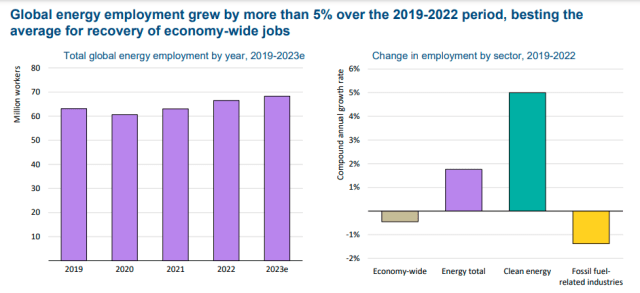The World Energy Employment (WEE) 2023 report from IEA said energy employment reached nearly 67 million in 2022 — growing by 3.4 million over prepandemic levels.
Clean energy sectors have added 4.7 million jobs over the same period and stand at 35 million, while fossil fuels jobs recovered more slowly after layoffs in 2020 and remain around 1.3 million below pre-pandemic employment levels, at 32 million.
As a result, clean energy employment surpassed that of fossil fuels in 2021. More than half of job growth in this period is attributable to just five sectors: solar PV, wind, electric vehicles (EVs) and battery manufacturing, heat pumps and critical minerals mining. These five sectors employ around 9 million workers today. Solar PV is the largest of these sectors, at around 4 million jobs, while manufacturing of EVs and their batteries was the largest source of growth, adding globally well over 1 million jobs since 2019.
Many of the new jobs are in construction and manufacturing, which represent over half of energy jobs today, and grew by 2.6 million jobs since 2019. The uptick of clean energy jobs occurred in every region of the world, with China’s energy workforce undergoing an unprecedented reorientation toward clean energy.
Clean energy jobs were the major driver of energy job growth in virtually all parts of the world over the last three years, but several regions also saw fossil fuel employment rise above 2019 levels, notably India, Indonesia, and the Middle East.

In regions that saw declines in fossil fuel jobs from 2019-22, clean energy outweighed these losses in all but a few, notably Russia and North Africa. China, home to the largest energy workforce today with nearly 30 percent of the global total, witnessed the largest rebalancing over the 2019-22 period, with clean energy jobs growing by 2 million and fossil fuel-related jobs falling by 600 000, largely in coal.
Today, 60 percent of China’s energy workforce is employed in clean sectors, compared to just over 50 percent in 2019. China’s build out of clean tech manufacturing has been a major source of employment growth.
China’s clean energy manufacturing sectors employ roughly 3 million workers, accounting for 80 percent of solar PV and EV battery manufacturing jobs globally. The energy sector needs higher skilled workers than most other industries — 36 percent of energy jobs are within high-skilled occupations by International Labour Organization definitions, compared with 27 percent in the broader economy.
Job vacancy rates, a key indicator of labour shortages, have been rising for years in many major economies in the construction, manufacturing, utility and other energy-related sectors. Construction occupations, which make up nearly half of new energy-related jobs to 2030 on a path to net zero, are facing particularly acute shortages, limiting the availability of labour needed to install clean energy technologies and retrofit buildings.
A proprietary survey of over 160 energy companies conducted by the IEA indicates that installation and repair work positions were the number one occupation segment for which respondents had the greatest difficulty hiring. This was mostly due to a lack of industry-specific knowledge.
Developing a sufficiently large and skilled local workforce is an imperative in every region, as most energy jobs are tied to the location where installations are developed. Roughly 60 percent of energy jobs today cannot be offshored.
The number of workers pursuing degrees or certifications relevant to energy sector jobs are not keeping pace with growing demand. Science, technology, engineering and mathematical degrees relevant to the energy sector are not rising fast enough to meet demand for new workers with these credentials. The gap is even more severe for vocational jobs.
Conferrals of certifications relevant to energy, such as electricians and heating technicians, have flatlined in the United States and the European Union, and in China they fell by around 9 percent per year in the years leading up to the pandemic.
Meanwhile, jobs demanding these certifications are projected to grow by around 8 percent per year through 2030 on a net zero aligned pathway. Clean energy training programmes are becoming more available — for instance 19 of the G20 members have training courses for solar PV installers — but governments must address direct and indirect costs borne by workers pursuing retraining if this skilled labour gap is to be closed. Cultivating a skilled labour pool should be considered a key strategic pillar for regions looking to be competitive in new clean energy industries, as is attracting more women, who represent 15 percent of the energy workforce today.

